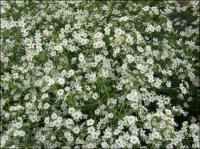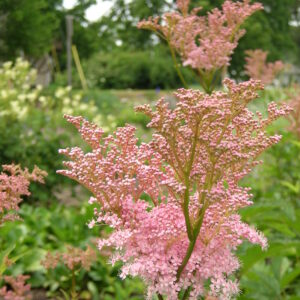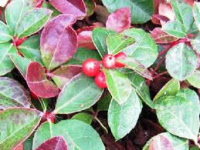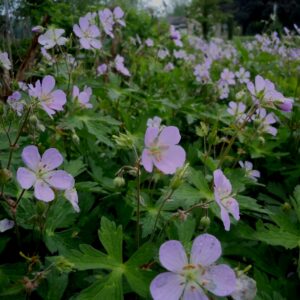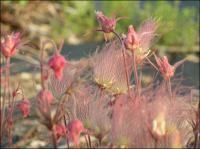Wisconsin Native
Showing 49–56 of 107 results
-
Erythronium americanum Yellow trout lily, Dog’s tooth violet Z 3-9
Downfacing yellow lily-like recurved flowers in spring above mottled foliage. Tops of petals slightly tan. Grows from deep rootstock or corm, 3-5” deep. In time it spreads from offshoots of the corm, resulting in colonies of trout lilies. Ephemeral – dies back in summer.
OUT OF STOCK – Only available for purchase in spring.
Downfacing yellow lily-like recurved flowers in spring above mottled foliage. Tops of petals slightly tan. Grows from deep rootstock or corm, 3-5” deep. In time it spreads from offshoots of the corm, resulting in colonies of trout lilies. Ephemeral – dies back in summer.
Size: 3-6” x 4”
Care: part to full shade in moist soil
Native: Eastern No. America, Wisconsin nativeCherokee warmed crushed leaves & poured the juice over wounds. According to Cherokee Yellow trout lily also remedied fever, fainting & removed slivers. Used by Iroquois as birth control for young women and to make fish bite (by chewing the root & spitting into the river.) In garden cultivation since 1665. Named Dog’s tooth because the white, oblong, fleshy root is shaped like a dog’s tooth.
-
Eupatorium purpureum syn. Eutrochium purpureum Sweet Joe Pye weed Z 4-9
July – September the top of each stem branches into several smaller stems. In turn a bundle of tubes grows out of each of these smaller stems and in turn more, thinner flowers grow out of each tube, forming a dusty rose dome a foot or more across.
July – September the top of each stem branches into several smaller stems. In turn a bundle of tubes grows out of each of these smaller stems and in turn more, thinner flowers grow out of each tube, forming a dusty rose dome a foot or more across.
Size: 5- 7’ x 3-4’
Care: Sun to part shade in moist, alkaline soil
Native: Eastern U.S., Wisconsin native
Wildlife Value: attracts bees and butterflies Monarch. Foliage feeds moth caterpillars.Named “Joe Pye weed” after an Indian medicine man who used the plant in New England to cure typhus. Meskwaki Indian men “nibbled (Joe Pye weed) when speaking to women when they are in the wooing mood.” This had the power of “fetching” women. Good luck when gambling for the Potawatomi. Oneidas used it to cure fever. Mahuna Indians of So. California made an infusion of the root to cure colds and coughs. Colonists used the plant to cure dropsy, gravel, gout, and rheumatism. Collected by Rev. John Banister who moved to colonial Virginia in 1678. A gunman mistakenly shot and killed him while he collected plants. Offered for sale in Bartram Garden’s 1783 Broadside, America’s 1st plant catalog.
-
Eupatorium sessilifolium Upland boneset Z 4-8b
Showy, flat to dome-topped, platter-like, numerous small-flower clusters of white bloom July to September
Showy, flat to dome-topped, platter-like, numerous small-flower clusters of white bloom July to September
Size: 3-5’ x 12-24”
Care: Shade to part shade in moist well-drained to dry soil (one of few dry shade flowers)
Native: Maine to Minnesota south to Kansas, east to Georgia. Wisconsin native (endangered, threatened or of special concern in 8 states – Indiana, Iowa, Maine, Michigan, Minnesota, New Hampshire, Vermont & Wisconsin
Wildlife Value: nectar attracts bees and butterflies. Foliage is food for their caterpillars. Deer & rabbit resistant.English botanist Rev. John Bannister (1654-1692) collected this in colonial Virginia. He was shot and killed by misadventure while collecting plants. Described by Scottish botanist Robert Morison (1620-1683) in Historis Plantarum Univeralis Oxoniensis pars tertia (vol. 3) 98, published posthumously in 1699.
-
Euphorbia corollata Flowering spurge Z 4-7
Small white flowers (bracts), like a baby's breath but better, July & August. One of the best prairie natives, but slow to mature.
Small white flowers (bracts), like a baby’s breath but better, July & August. One of the best prairie natives but slow to mature.
Size: 36' x 24" spreading slowly
Care: sun in well-drained to moist well-drained soil. Drought resistant.
Native: Canada to Florida and west through the plains, Wisconsin native
Wildlife Value: deer resistant. Its pollen & nectar feed endangered Karner Blue butterfly as well as other small butterflies, numerous bees, wasps and flies. Several birds eat the seeds.A favorite medicine among native Americans. Cherokee rubbed the plant’s juice on skin to cure cancer. Also used to remedy tooth aches and gonorrhea. Winnebago cut a 2.5” long root to clear stomach and steeped leaves for a baby’s colic. According to Breck (1851), “One of the most elegant species peculiar to the United States.”
-
Filipendula rubra ‘Venusta’ Queen of the prairie Z 3-9
Extraordinary frothy pink plumes, like cotton candy, blooming in midsummer
Extraordinary frothy pink plumes, like cotton candy, blooming in midsummer
Size: 4-6’ x 4-5'
Care: sun to part shade in moist well-drained to moist soil
Native: US East coast west to MN s to MO and NC, Wisconsin native
Wildlife Value: This creates pollen but not nectar limiting the pollinators to bees and flies (Butterflies and wasps want nectar.).
Awards: Award of Garden Merit from England’s Royal Horticultural Society.Name is Latin filum pendulus meaning hanging by thread referring to threads on the roots of another species.
Wildlife value: This creates pollen but not nectar limiting the pollinators to bees and flies (Butterflies and wasps want nectar.)
Meskwaki Indians used the species for heart ailments and as an aphrodisiac. Although the plant’s name has been changed five times, the species was 1st described in 1768. Robinson, Rhodora, v. 8 pp. 202-205 (1907). “Filipendulina, a New Binomial,” The flowers of this cultivar are darker than the species. Described by German botanist Andreas Voss (1857-1922). -
Gaultheria procumbens Wintergreen, Checkerberry, Teaberry Z 3-8
“Gaultheria procumbens is in absolute perfection and beautiful – first as regards its bell-shaped blossoms, and afterwards its berries…” The Garden January 1876.
OUT OF STOCK
“Gaultheria procumbens is in absolute perfection and beautiful – first as regards its bell-shaped blossoms, and afterwards its berries…” The Garden , January 1876.
Size: 4” x 2’, spreading slowly - will make dense groundcover in time.
Care: part shade in moist to moist well-drained, acidic soil
Native: Eastern North America – Canada to Georgia west to Wisconsin
Awards: England’s Royal Horticultural Society Award of Merit.Ojibwa made tea from the leaves; the tea “makes them feel good.” Oneida used this for women having a painful menstrual cycle. For the Algonquin Wintergreen cured the common cold, headaches, grippe and stomachaches. Cherokee cured swollen gums and colds. Berries described as a grape in 1717. Named by Swedish botanist Peter Kalm after Dr. Gaulthier, with whom he botanized in Canada in 1749. Sold in America’s 1st plant catalog, Bartram’s Broadside, 1783. During the American Revolution when tea became unavailable, colonists used the plant to make tea. The tea reputedly relieved pain from headaches, muscle pains and colds. The leaves contain oil effective against pain – methyl salicylate. Pressed specimen in Emily Dickinson’s herbarium.
-
Geranium maculatum American Cranesbill, Wild geranium, Spotted geranium Z 3-8
Clusters of two to five pink infused with lavender, flowers of five, paddle-shaped petals bloom in late spring to early summer.
Clusters of two to five pink infused with lavender, flowers of five, paddle-shaped petals bloom in late spring to early summer.
Size: 24" x 18"
Care: Full sun to part shade in moist to moist well-drained soil
Native: East North America, Wisconsin native.
Wildlife Value: primarily visited by several kinds of bees.Native Americans taught colonists to use the plant to cure diarrhea, dysentery, and hemorrhaging. Also used on sores, open wounds, canker sores and sore feet. The Choctaw prescribed it for venereal disease. Sent to Europe in 1732. Jefferson asked John Bartram to obtain seeds, 1786. Collected by French plant hunter André Michaux (1746-1802). Pressed specimen in Emily Dickinson’s herbarium.
-
Geum triflorum Prairie smoke, Old Man’s whiskers Z 3-7
Pale purplish-pink dangling cup-shaped flowers in spring to early summer, followed by hair-like, pink seed heads like the hair on a troll doll.
Pale purplish-pink dangling cup-shaped flowers in spring to early summer, followed by hair-like, pink seed heads like the hair on a troll doll.
Size: 10" x 8" but slow to grow to this width
Care: sun in well-drained to moist well-drained soil
Native: all of northern No. America, Wisconsin native
Wildlife Value: attracts butterflies, bees, wasps, and moths. Resists deer and rabbits.
Awards: Great Plants for Great PlainsIntroduced to gardens in 1609. Many Native American medicinal uses. Blackfeet used it to cure coughs, skin sores and wounds on people and horses, swollen eyes, canker sores, and fuzzy thinking in people. Crushed, ripe seeds made a perfume. Okanagan-Colville women made a love potion from the roots, as well as curing vaginal yeast infections. The Eastern Cascades of Canada brewed a medicinal tea for eye-wash, sore throats, and general aches from the plant. Sioux used it for many ailments: sore eyes, canker sores, sore throat, perfume, wounds, and added it to mixtures of plants for smoking. Collected by Meriwether Lewis on June 12, 1806 on the Weippe Prairie, not far from the villages of the Nez Perce in Idaho.




